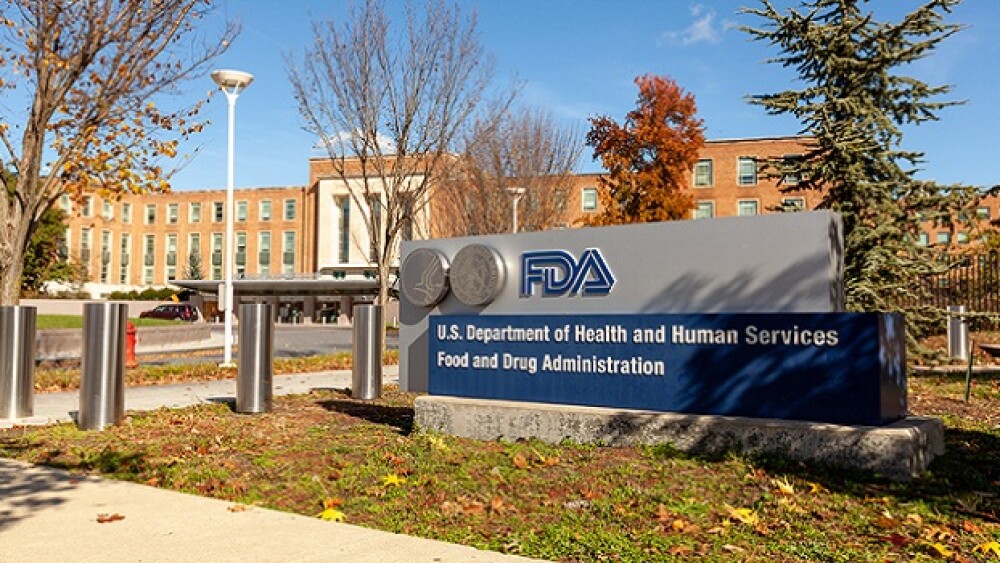From ALS to depression to Huntington’s disease, many neuroscience-focused companies are anticipating key data over the next few months.
Pictured: a physician looks at a brain scan on a computer screen/iStock, gorodenkoff
With a plethora of promising candidates moving through clinical trials, there are several upcoming data readouts of interest in both the neurodegenerative and neuropsychiatric spaces. Targeting amyotrophic lateral sclerosis (ALS), major depressive disorder, Huntington’s disease and many other worthy indications, here are six mid- to late-stage data readouts for candidates you’ll want to have on your radar.
1. Sanofi and Denali’s SAR443820/DNL788
Amyotrophic lateral sclerosis
In the ALS space, Sanofi is expected to announce topline results from the Phase II HIMALAYA trial of SAR443820/DNL788, which it is developing with partner Denali Therapeutics, according to a Denali press release. SAR443820/DNL788 is a small molecule inhibitor of RIPK1, a critical signaling protein in a canonical inflammatory and cell death pathway, according to Denali. Increased RIPK1 activity in the central nervous system is thought to drive neuroinflammation and cell death, contributing to neurodegeneration.
Part A of the double-blinded, randomized, placebo-controlled HIMALAYA trial, which has completed enrolling all 305 participants, involves evaluating patients’ change from baseline on the ALS Functional Rating Scale-Revised (ALSFRS-R), a tool used to determine disease progression. The primary outcome for Part B of the HIMALAYA program, the open-label extension, is the combined assessment of the function and survival (CAFS) score.
SAR443820/DNL788 holds the FDA’s Fast Track designation for the treatment of ALS. Sanofi and Denali are also developing SAR443820/DNL788 for multiple sclerosis, for which it is being tested in the Phase II K2 study.
2. Intra-Cellular Therapies’ Lumateperone
Major depressive disorder
According to Graig Suvannavejh, senior biopharmaceuticals and biotechnology equity research analyst at Mizuho Americas, major depressive disorder (MDD) is an area to watch this year. “There are several readouts in major depressive disorder,” he told BioSpace. Among those, he highlighted anticipated Phase III datasets for Intra-Cellular Therapies’ Caplyta (lumateperone).
Intra-Cellular’s lead asset, lumateperone won approval in 2019 for schizophrenia and received a label expansion in December 2021 for depressive episodes associated with bipolar disorder. Now the company is seeking a third indication, MDD, and expects data from two Phase III studies during the first half of 2024.
Lumateperone, an oral antipsychotic medication, is currently being assessed in a three-part Phase III program for MDD. Studies 501, 502 and 505 are testing the drug in adult patients who are having inadequate response to an approved antidepressant. The primary endpoint for these studies is change in Montgomery Asberg Depression Rating Scale (MADRS) total score after six weeks, while a key secondary endpoint is change in CGI-S score over the same period of time. The company anticipates topline data from Study 501 in the first quarter of 2024 and for Study 502 in Q2, according to a January corporate presentation.
In another Phase III trial, reported in March 2023, lumateperone eased the burden of depressive episodes in patients with MDD or bipolar depression with mixed features. Suvannavejh said these data, along with lumateperone’s approval for depressive episodes associated with bipolar disorder, “gives us a level of confidence” in the drug.
3. Annexon Biosciences’ ANX005
Guillain-Barré syndrome
Brisbane, Calif.–based Annexon Biosciences is expecting pivotal data from a Phase III trial of its lead candidate ANX005, being developed for Guillain-Barré syndrome (GBS), during the first six months of 2024. There are no FDA-approved treatments for GBS, a potentially fatal, serious autoimmune condition of the nervous system that can cause paralysis, neurodegeneration and cognitive impairment, according to an Annexon press release outlining expected 2024 milestones.
GBS is caused by an autoantibody attack on the peripheral nerves, triggering the complement cascade (C1q). ANX005 is designed to inhibit C1s along with the entire complement pathway. It has received both Fast Track and Orphan Drug designations from the FDA in this indication.
A Phase III study testing the efficacy, safety, pharmacokinetics and pharmacodynamics of ANX005, an investigational monoclonal antibody, completed enrollment in 2023 and is on track to read out data before July, Annexon noted in the press release.
In a Phase Ib trial, ANX005 “showed rapid and consistent improvement in muscle strength” and “improvement in neuronal damage and clinical function in patients with GBS,” according to Annexon.
4. Wave Life Sciences’ WVE-003
Huntington’s disease
One of the most intractable neurodegenerative illnesses, Huntington’s disease continues to stump biopharma, but companies aren’t giving up. One of these is Cambridge, Mass.–based Wave Life Sciences, which is testing an antisense therapy, WVE-003, in the Phase Ib/IIa SELECT-HD trial. Wave anticipates sharing data from the 30 mg multi-dose cohort of this study with extended follow-up, along with all single-dose data, in the second quarter of 2024, according to a company press release outlining 2024 milestones.
Huntington’s disease is caused by a CAG repeat in the first exon of the huntingtin (HTT) gene. This mutation causes brain cells to die, leading to a host of progressive cognitive, psychiatric and movement symptoms, including an involuntary jerking or writhing movement, also known as chorea.
WVE-003 is designed to preferentially lower mutant HTT (mHTT) protein levels by targeting a single nucleotide polymorphism called SNP3 that appears on the mHTT transcript, Wave CEO Paul Bolno told BioSpace in a previous interview. An estimated 40% of adults with Huntington’s carry SNP3 in association with the Huntington’s mutation, Bolno said.
Wave presented data in September 2022 from SELECT-HD showing early indications of decreases in mHTT in the cerebrospinal fluid. Wildtype HTT [wtHTT]—the good type of huntingtin protein—was preserved at both doses, the company reported.
A recently posted preclinical study reinforced the importance of wtHTT-sparing biology and that the protein’s preservation is also “important in delaying the progression of the disease,” Bolno told BioSpace last week. “These data will be the first repeat-dose assessment of wildtype [huntingtin] preservation with mutant huntingtin knockdown.”
For Wave, the anticipated results also have implications for an existing collaboration agreement with Takeda, which has the option to co-develop and co-commercialize WVE-003. Per the press release, these data are expected to inform Takeda’s decision on whether or not to opt in. However, under the terms of the agreement, Wave retains control of development and regulatory approval in either case, Bolno noted. So the company is more focused on whether the program “goes the distance in terms of delivering a medicine to patients,” he said.
5 and 6. Praxis Precision Medicines’ PRAX-562 and PRAX-628
Epilepsy
Two key anticipated data readouts in the epilepsy space come from Praxis Precision Medicines.
First, topline results from the Phase IIa PPR study of PRAX-628 in patients with photo-paroxysmal response (PPR) epilepsy are expected in the first quarter of this year. Positive preliminary analysis of the study’s 15-mg cohort “exceeds expectations” in terms of drug activity, according to a Praxis clinical portfolio update. The new data are expected to be released following completion of the 45-mg cohort.
PRAX-628, which targets focal epilepsy, is a next-generation, functionally selective small molecule targeting the hyperexcitable state of sodium-channels in the brain. Initial data show the candidate “has a good tolerability profile, a potentially wide therapeutic index” and the ability to reach efficacious concentrations within 24 hours, according to Praxis.
Also expected during the first half of 2024 are results from the Phase II EMBOLD study testing PRAX-562, a unique sodium channel modulator, in pediatric patients with SCN2A and SCN8A developmental epilepsies.
PRAX-628 and PRAX-562 are both based on Praxis’ Cerebrum small molecule platform, which leverages a “deep understanding of neuronal excitability and neuronal networks,” according to Praxis’ website.
Heather McKenzie is a senior editor at BioSpace. You can reach her at heather.mckenzie@biospace.com. Also follow her on LinkedIn.






